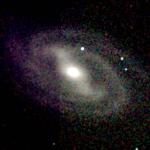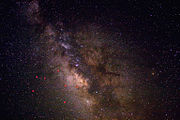Etymology and beliefs
There are many creation myths around the world which explain the origin of the Milky Way and give it its name. The English phrase is a translation from Greek Γαλαξίας, Galaxias, which is derived from the word for milk (γάλα, gala). This is also the origin of the word galaxy. Indians call it the Akashganga or a celestial form of the holy river, Ganga.[citation needed] In Greek myth, the Milky Way was caused by milk spilt by Hera when suckling Heracles.
The term Milky Way first appeared in English literature in a poem by Chaucer.
"See yonder, lo, the Galaxyë
Which men clepeth the Milky Wey,
For hit is whyt."—Geoffrey Chaucer, Geoffrey Chaucer The House of Fame, c. 1380.[47]
In a large area from Central Asia to Africa, the name for the Milky Way is related to the word for straw. It has been claimed that this was spread by Arabs who in turn borrowed the word from Armenian.[48] In several Uralic, Turkic languages, Fenno-Ugric languages and in the Baltic languages the Milky Way is called the "Birds' Path". The Chinese name "Silver River" (銀河) is used throughout East Asia, including Korea and Japan. An alternative name for the Milky Way in ancient China, especially in poems, is "Heavenly Han River"(天汉). In Japanese, "Silver River" (銀河 ginga) means galaxies in general and the Milky Way is called the "Silver River System" (銀河系 gingakei) or the "River of Heaven" (天の川 Amanokawa or Amanokawa). In Swedish, it is called Vintergatan, or "Winter Street", because the stars in the belt were used to predict time of the approaching winter.[citation needed]
Discovery
- See also: Galaxy—Observation history
As Aristotle (384-322 BC) informs us in Meteorologica (DK 59 A80), the Greek philosophers Anaxagoras (ca. 500–428 BC) and Democritus (450–370 BC) proposed that the Milky Way might consist of distant stars. However, Aristotle himself believed the Milky Way to be caused by "the ignition of the fiery exhalation of some stars which were large, numerous and close together" and that the "ignition takes place in the upper part of the atmosphere, in the region of the world which is continuous with the heavenly motions."[49] The Arabian astronomer, Alhazen (965-1037 AD), refuted this by making the first attempt at observing and measuring the Milky Way's parallax,[50] and he thus "determined that because the Milky Way had no parallax, it was very remote from the earth and did not belong to the atmosphere."[51]
The Persian astronomer, Abū Rayhān al-Bīrūnī (973-1048), proposed the Milky Way galaxy to be a collection of countless nebulous stars.[52] Avempace (d. 1138) proposed the Milky Way to be made up of many stars but appears to be a continuous image due to the effect of refraction in the Earth's atmosphere.[49] Ibn Qayyim Al-Jawziyya (1292-1350) proposed the Milky Way galaxy to be "a myriad of tiny stars packed together in the sphere of the fixed stars" and that that these stars are larger than planets.[53]
Actual proof of the Milky Way consisting of many stars came in 1610 when Galileo Galilei used a telescope to study the Milky Way and discovered that it was composed of a huge number of faint stars.[54] In a treatise in 1755, Immanuel Kant, drawing on earlier work by Thomas Wright, speculated (correctly) that the Milky Way might be a rotating body of a huge number of stars, held together by gravitational forces akin to the Solar System but on much larger scales. The resulting disk of stars would be seen as a band on the sky from our perspective inside the disk. Kant also conjectured that some of the nebulae visible in the night sky might be separate "galaxies" themselves, similar to our own.[55]
The first attempt to describe the shape of the Milky Way and the position of the Sun within it was carried out by William Herschel in 1785 by carefully counting the number of stars in different regions of the sky. He produced a diagram of the shape of the Galaxy with the Solar System close to the center.

In 1845, Lord Rosse constructed a new telescope and was able to distinguish between elliptical and spiral-shaped nebulae. He also managed to make out individual point sources in some of these nebulae, lending credence to Kant's earlier conjecture.[56]
In 1917, Heber Curtis had observed the nova S Andromedae within the "Great Andromeda Nebula" (Messier object M31). Searching the photographic record, he found 11 more novae. Curtis noticed that these novae were, on average, 10 magnitudes fainter than those that occurred within our galaxy. As a result he was able to come up with a distance estimate of 150,000 parsecs. He became a proponent of the "island universes" hypothesis, which held that the spiral nebulae were actually independent galaxies.[57] In 1920 the Great Debate took place between Harlow Shapley and Heber Curtis, concerning the nature of the Milky Way, spiral nebulae, and the dimensions of the universe. To support his claim that the Great Andromeda Nebula was an external galaxy, Curtis noted the appearance of dark lanes resembling the dust clouds in the Milky Way, as well as the significant Doppler shift.[58]
The matter was conclusively settled by Edwin Hubble in the early 1920s using a new telescope. He was able to resolve the outer parts of some spiral nebulae as collections of individual stars and identified some Cepheid variables, thus allowing him to estimate the distance to the nebulae: they were far too distant to be part of the Milky Way.[59] In 1936 Hubble produced a classification system for galaxies that is used to this day, the Hubble sequence.






